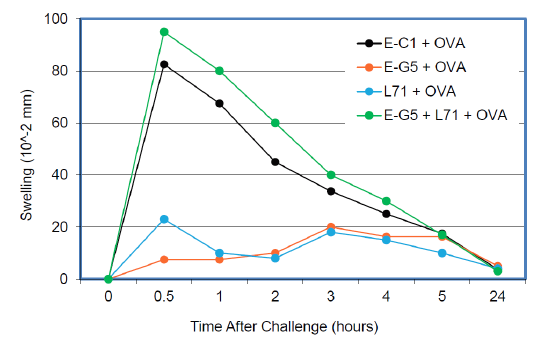OVA Monoclonal Antibodies & Elisa Kits
|
Ovalbumin From Chick Egg White |
||||
|
Products |
Quantity |
Catalog # |
||
|
50 mg, Lyophilized |
||||
|
10 mg, Lyophilized |
||||
|
Mouse Anti-OVA IgE and IgG Monoclonal Antibodies |
||||
|
Product |
Mast Cell Activation |
Hypersensitivity Reaction |
Quantity |
Catalog # |
|
Yes |
Yes |
1 mg, Lyophilized |
||
|
No |
No |
1 mg, Lyophilized |
||
|
No |
No |
1 mg, Lyophilized |
||
|
Mouse Anti-OVA Antibody and Total Immunoglobulin ELISA Kits |
||||
|
Products |
Anti-HDM (Catalog #) |
Total Immunoglobulin (Catalog #) |
||
|
IgE Antibody Assay Kit |
||||
|
Serum IgE Antibody Assay Kit |
- |
|||
|
IgG Antibody Assay Kit |
||||
|
IgG1 Antibody Assay Kit |
||||
|
IgG2a Antibody Assay Kit |
||||
|
IgG2b Antibody Assay Kit |
||||
|
IgG2c Antibody Assay Kit |
- |
|||
|
IgG3 Antibody Assay Kit |
- |
|||
|
IgM Antibody Assay Kit |
||||
|
IgA Antibody Assay Kit |
||||
Typical mouse OVA asthma models take several weeks to induce asthma because anti-OVA antibody production is essential. To bypass this rate-limiting step, a newly-developed asthma mouse model uses an anti-OVA IgE monoclonal antibody (mAb) rather than OVA for sensitization, resulting in a one-week study as shown in Figure 1 (1,2). Chondrex, Inc. provides mouse anti-OVA IgE mAbs, allergenic E-C1 and non-allergenic E-G5, anti-OVA IgG mAb L71, and related kits for studying allergic diseases, such as in-vivo hypersensitivity reactions for in-vitro and in-vivo experiments.
General Protocols for Inducing Asthma in Balb/c Mice
OVA/Alum-Induced Asthma

Anti-OVA/IgE-Induced Asthma

Interestingly, anti-OVA IgG synergistically develops an allergic reaction with non-allergenic IgE. This result indicates that anti-allergen IgG may play pathogenic roles in allergic diseases by forming multivalent antigen complexes which bind to IgE on the surfaces of mast cells, rather than competing with IgE for its allergenic epitopes (3).
Footpad Swelling in Mice with Anti-OVA IgEs
Balb/c mice received 10 μg of anti-OVA monoclonal IgE antibodies (allergenic E-C1 and non-allergenic E-G5) and IgG1 (L71) by IV injection, then were challenged with OVA (50 μg) by intradermal injection at the footpad after 24 hours. Footpad thickness was determined with a Loop Handle Dial Thickness Gauge and shown in mm. Sensitization with E-C1 resulted in a hypersensitivity reaction as indicated by footpad swelling (black). In contrast, E-G5 (orange) and L71 (blue) did not induce individual hypersensitivity reactions.
However, co-injection of E-G5 and L71 synergistically induced a hypersensitivity reaction (green) commensurate to E-C1.

